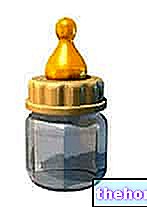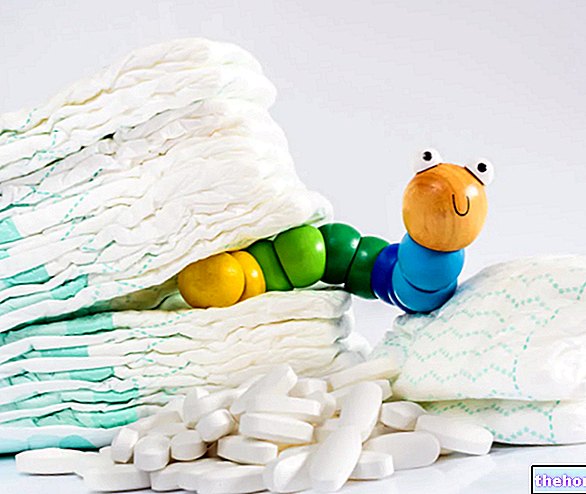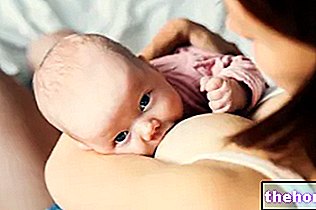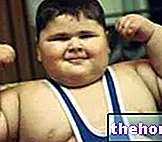The importance of water is obviously to be found in its functions, which are:
- Regulate cell volume and body temperature;
- Promote digestive processes;
- Allow the transport of nutrients and the removal of metabolic waste.
The lack of water in the human body is called dehydration.
Associated with a loss of salts, dehydration is a very dangerous condition: a decrease of 6-7% of the total body water, in fact, is sufficient to endanger the survival of the human being.
As anticipated, in children, the water present in the organism represents 80% of the body weight.
To prevent a child from going into a state of dehydration, it is essential to pay attention to everything that causes a loss of body water and to provide an adequate supply of the nutrient from the outside. For example, it is very important to take into account the consistency of the stool. (the presence of protracted diarrhea leads to a considerable loss of water) or a condition of repeated vomiting; moreover, it is essential to consider the water losses occurring through sweating (losses affected by factors such as the individual's motor activity and, especially in the little ones, clothing).
Dehydration in Children: Why is it Dangerous?
In both children and adults, dehydration is dangerous for several reasons; here's what:
- In a dehydrated body, the sweating mechanism is blocked, thus saving the little water left in the body.
The lack of sweat secretion, however, causes a considerable organic overheating, with negative repercussions on the hypothalamic thermoregulatory center (see article dedicated to heat stroke). - In the presence of dehydration, the blood volume is reduced; consequently, the blood circulates less well in the vessels, the heart gets tired and, in extreme cases, cardio-circulatory collapse may arise.
Very often, the two aforementioned situations are concomitant, ie a conspicuous loss of water is not followed by an adequate supply of liquids from the outside.
It is important to point out that, although it may seem the most obvious remedy, the administration of liquids by mouth is not always feasible: it is the case, for example, of a child with vomiting, who is unable to retain any liquid ingested by mouth.
Causes of Dehydration in Children: What Are They?
The most common cause of severe dehydration in children is acute gastroenteritis.
Very rare under three months of age, acute gastroenteritis consists of a violent inflammation of the internal walls of the stomach and intestine, characterized by diarrhea and mainly sustained by viral infections (Rotavirus, Norwalk virus and Adenovirus).
It should be noted that vomiting may also be present in the initial stages of this inflammatory condition.
Other causes of dehydration in children include:
- Bacterial gastroenteritis, due to microorganisms such as, for example, Salmonella, Escherichia coli, Campylobacter or Clostridium difficile;
- Type I diabetes;
- Cystic fibrosis;
- The syndromes of malabsorption.
Dehydration in Children: Degrees and Symptoms
It is possible to distinguish three degrees (or levels) of dehydration in children:
- Mild dehydration, in which water loss is 3-5% of the total body weight;
- Moderate dehydration, in which water loss is equal to 6-9% of the total body weight;
- Severe dehydration, in which the loss of water is equal to or greater than 10% of the total body weight.
Mild Dehydration in Children: Symptoms
Generally, when it is mild, dehydration in children is asymptomatic. This is dangerous, as parents may not be aware of the problem.
Moderate Dehydration in Children: Symptoms
In the presence of moderate dehydration, the little patient becomes ill and manifests thirst, irritability, cold, dry and inelastic skin, dry lips and mucous membranes, sunken eyes, reduced lacrimation, reduced urination frequency and sunken fontanel ( in the infant).
In the presence of these symptoms, parents should contact the pediatrician immediately.
Severe Dehydration in Children: Symptoms
When it is severe, in addition to the previous symptoms, dehydration in children also leads to lethargy, tachycardia (increased number of heartbeats), tachypnea (increased number of breaths) and a lengthening of the capillary refill time.
At these levels, dehydration represents a "medical emergency, to be treated in the emergency room. Here, doctors will first assess the small patient's salt and water balance conditions; then, subsequently, they will adequately correct the losses of water and of salts by means of parenteral infusions (the loss of water involves, in parallel, a dispersion of salts).
Dehydration in Children: Associated Conditions
Generally, dehydration in children is associated (as it is a consequence of it) with conditions, such as:
- He retched;
- Diarrhea;
- Fever greater than 38 ° C.
In particular, the objective examination deserves further attention:
- This investigation allows us to trace the degree of dehydration of the little patient; by comparing the usual weight of the child with that measured at the suspicion of dehydration, in fact, it is possible to calculate the water deficit.
- Furthermore, during the physical examination, the doctor measures another important parameter for estimating the degree of severity of dehydration: the so-called capillary filling time.
The capillary filling time (CRT) is a non-invasive diagnostic test, which allows you to evaluate systemic perfusion very quickly and consists of compressing the capillary bed (usually on the palm of the hand or fingertip) and counting the time taken for the reappearance flow, referring to the change in skin color.
If the capillary filling time is greater than 2 seconds, it is part of the pathological.
Individuals in a state of dehydration have an extended capillary refill time.
Clinical Dehydration Scale
A useful tool for estimating dehydration in children, which doctors use but which can also be useful for parents, is the so-called clinical dehydration scale.
The clinical dehydration scale takes into account the typical symptoms of dehydration in the child and assigns them an increasing score from 0 to 2, based on their severity; it considers, for example, tearing and assigns a score of 0, if it is normal, of 1, if it is only partially reduced, and of 2, if it is absent.
If the combined result of the various symptom scores is greater than 5, the little patient is in a state of moderate or severe dehydration.
; therefore, a 20 kilo child with 5% dehydration lost one kilo of body weight (0.05 x 20 kg = 1 kg); therefore, it has a fluid deficit of one liter.In mild and moderate dehydration, oral moisturizing therapy is the method of first choice; it is based on the administration of special hyposmolar drinks, which can be purchased in pharmacies, such as Pedialyte or Infalytr.
For children over the age of two, rehydrating sports drinks can also be used.
The guidelines recommend starting therapy by administering orally 5 ml of rehydrating solution every five minutes, gradually increasing it according to tolerability.
More generally, it is important to administer small amounts of fluids at very frequent intervals.
For no reason use fizzy drinks and fruit juices, which - being solutions rich in sugar, therefore hyperosmolar - would worsen diarrhea and dehydration.
Simple water, on the other hand, usually does not contain enough mineral salts and can cause electrolyte imbalances, with the risk of convulsions.
If you do not have rehydrating drinks available, the ideal is to prepare them yourself, dissolving four teaspoons of sugar, half a teaspoon of salt, half a teaspoon of potassium chloride and half a teaspoon of sodium bicarbonate in a liter of water.
Normal nutrition will be resumed as soon as the child is able to tolerate it.
At the hospital level, when the child presents with severe dehydration, or if it is not possible to rehydrate orally due to persistent vomiting, intravenous therapy is used (infused with boluses of 20 ml / kg until the shock is resolved. ). Vomiting, in itself, does not represent a contraindication to oral rehydration and can be resolved through the use of antiemetics (obviously as recommended by the pediatrician).




























